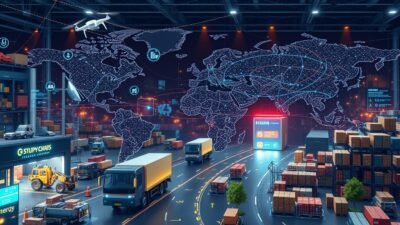India’s updated Foreign Trade Policy marks a turning point in global commerce. This overhaul aims to reshape business dealings and boost the country’s digital economy. It sets the stage for a new era in international trade relations.
The policy introduces changes to streamline processes and embrace digital innovations. It also focuses on fostering sustainable growth. These reforms will benefit businesses of all sizes across India’s economy.
The new policy aims to position India as a leader in the global marketplace. It introduces measures to help the country adapt to rapidly changing trade dynamics. Let’s explore the key aspects of this groundbreaking policy.
Preparing for the UGC NET exam can be a daunting task, but with the right resources, candidates can navigate the process effectively. Websites like MyJRF provide a comprehensive platform for aspiring educators, offering specialized guidance for UGC NET Paper 2 preparation and essential tips for acing UGC NET Paper 1. Additionally, understanding the revised syllabus provided by UGC is crucial for a targeted study approach. For official announcements and updates, candidates should regularly visit the UGC NET NTA portal, while the UGC’s job section and the main UGC website are invaluable for post-exam opportunities and academic resources. With these tools, candidates can maximize their preparation and set themselves up for success.
Key Takeaways
- Digitalization of trade processes to enhance efficiency
- Focus on sustainable and eco-friendly commerce practices
- Simplified procedures to boost exports and imports
- Support for MSMEs to access global markets
- Integration of blockchain technology in trade operations
- Emphasis on agricultural exports and market access
- Adaptation strategies for global supply chain challenges
Understanding India’s Foreign Trade Policy Overview
India’s Foreign Trade Policy shapes the nation’s commerce landscape. It guides international trade relations and fosters economic growth. This policy framework is crucial in today’s interconnected global market.
What is Foreign Trade Policy?
Foreign Trade Policy regulates imports and exports. It aims to boost India’s trade position globally. The policy covers various aspects of commerce, including e-commerce trends.
Objectives of the Updated Policy
The updated policy focuses on:
- Increasing exports
- Simplifying trade procedures
- Enhancing India’s global competitiveness
- Promoting digital commerce initiatives
Importance for Indian Commerce
This policy is vital for Indian commerce as it:
- Opens new markets for Indian goods
- Encourages foreign investment
- Supports the growth of e-commerce
- Boosts job creation in trade-related sectors
| Policy Area | Impact on Commerce |
|---|---|
| Digital Trade | Facilitates online shopping growth |
| Export Promotion | Increases global market share |
| Trade Facilitation | Reduces costs for businesses |
India’s Foreign Trade Policy creates a strong framework for modern commerce. It supports both traditional and online businesses. The policy aims to boost India’s position in the global market.
Key Changes in Trade Regulations
India’s new Foreign Trade Policy brings big changes to commerce and retail. These changes aim to simplify trade and make India more competitive globally.
Introduction of Digital Signatures
The policy now accepts digital signatures for trade documents. This cuts paperwork and speeds up import-export activities. Retailers can now finish transactions faster, boosting efficiency in commerce.
Streamlining Import Processes
Import procedures are now simpler, making transactions smoother. A single-window clearance system reduces bureaucratic hurdles. This helps retailers by cutting delays and costs when importing goods.
Enhanced Export Benefits
Exporters now get more incentives under the revised policy. These benefits include higher duty drawback rates and expanded RoDTEP scheme coverage. The policy also simplifies documentation for export transactions.
- Higher duty drawback rates
- Expanded coverage of the Remission of Duties and Taxes on Exported Products (RoDTEP) scheme
- Simplified documentation for export transactions
These changes aim to make India more competitive in global exports.
| Regulation Change | Impact on Commerce | Benefits for Retailers |
|---|---|---|
| Digital Signatures | Faster document processing | Quicker transactions |
| Streamlined Imports | Reduced clearance time | Lower inventory costs |
| Enhanced Export Benefits | Increased export competitiveness | Higher profit margins |
These changes modernize India’s trade ecosystem. They promise to make business easier for domestic and international players in commerce and retail.
Focus on Sustainable Development
India’s new Foreign Trade Policy emphasizes sustainable development in commerce. This approach balances economic growth with environmental responsibility in the digital economy. It shows a growing awareness of eco-friendly practices.
Green Trade Initiatives
The policy introduces green trade initiatives to reduce environmental impact in commerce. It offers incentives for businesses adopting eco-friendly practices in supply chains and production. Companies using renewable energy or reducing waste may qualify for benefits.
Promoting Eco-Friendly Products
The policy focuses on promoting eco-friendly products in domestic and international markets. This includes several key measures:
- Reduced import duties on environmentally friendly technologies
- Streamlined certification processes for organic and sustainable products
- Support for research and development in green technologies
These steps aim to boost production and export of sustainable goods. They position India as a leader in the global eco-friendly product market.
| Initiative | Impact on Commerce | Environmental Benefit |
|---|---|---|
| Green Certification Program | Increased exports of certified eco-friendly products | Reduced carbon footprint in production |
| Renewable Energy Incentives | Lower operational costs for businesses | Decreased reliance on fossil fuels |
| Sustainable Packaging Regulations | New market opportunities for packaging innovators | Reduction in plastic waste |
India sets a new standard for responsible commerce by integrating sustainability into trade policies. These initiatives protect the environment and create opportunities in the green economy sector.
The policy fosters a shift towards eco-friendly practices in the electronic commerce era. It opens new avenues for businesses to thrive while prioritizing environmental stewardship.
Role of Technology in Trade
Technology is changing India’s trade scene. Digital tools are reshaping commerce and online shopping. These changes create new chances and improve trade processes.
Digital Trade Platforms
Digital trade platforms are changing India’s trade world. They make buying and selling easier, with less paperwork. Big and small businesses use these online markets to reach more customers.
E-commerce Enhancements
E-commerce in India is growing fast. Online shopping is popular due to better payment and delivery systems. Mobile shopping lets people buy anytime, anywhere.
These improvements are spreading e-commerce across cities and villages.
Blockchain Applications in Commerce
Blockchain is entering Indian trade. It offers safe and clear transactions, reducing fraud. Supply chains use blockchain to track products and improve shipping.
| Technology | Impact on Trade | Benefits |
|---|---|---|
| Digital Platforms | Streamlined transactions | Reduced paperwork, increased efficiency |
| E-commerce | Expanded market reach | Convenient shopping, faster deliveries |
| Blockchain | Enhanced security | Transparent transactions, improved traceability |
As tech grows, it will keep changing trade in India. These digital tools will boost business and connect traders more.
Impact on Small and Medium Enterprises
India’s new Foreign Trade Policy brings big changes for small and medium enterprises. These changes aim to boost retail and online business for smaller players. The policy focuses on helping these businesses grow.
Support for MSMEs
The policy offers targeted support for Micro, Small, and Medium Enterprises (MSMEs). This includes financial help, skill training, and tech adoption programs. These steps help MSMEs compete better in the changing retail world.
Access to Global Markets
SMEs now have better access to global markets through export promotion councils. These councils provide market info and help with international trade fairs. They also guide businesses on meeting global standards.
Simplified Procedures for Exporters
The policy makes export procedures easier for SMEs. It cuts down on red tape and paperwork.
- Single-window clearance system for export documentation
- Reduced paperwork for customs clearance
- Faster processing of duty drawback claims
These changes make it simpler for small retailers to trade globally. This helps grow India’s commerce sector. Small businesses can now expand beyond local markets more easily.
Trade Partnerships and Agreements
India’s new Foreign Trade Policy aims to expand global commerce through strategic partnerships. It focuses on boosting business and strengthening the digital economy. The policy outlines new agreements and reinforces existing trade relations.
New Bilateral Agreements
India has signed new trade agreements with key partners. These deals aim to reduce trade barriers and promote digital commerce. The India-UAE CEPA targets increasing bilateral trade to $100 billion by 2030.
Strengthening Multilateral Trade Relations
The policy reaffirms India’s commitment to multilateral trade forums. It outlines strategies to engage with the WTO and regional blocs. This approach aims to create a favorable environment for Indian businesses globally.
| Trade Agreement | Partner | Key Focus Areas |
|---|---|---|
| CEPA | UAE | Goods, services, digital trade |
| ECTA | Australia | Agriculture, textiles, pharmaceuticals |
| FTA | UK | Technology, finance, sustainable development |
These agreements are set to transform India’s commerce landscape. They create new opportunities for cross-border business transactions. The focus on digital economy integration positions India for growth in global trade.
Encouraging Foreign Direct Investment (FDI)
India’s updated Foreign Trade Policy focuses on attracting Foreign Direct Investment (FDI). This strategy aims to boost the economy and drive technological advancement. International capital inflows are expected to play a crucial role in this process.
Incentives for Foreign Investors
The policy offers various incentives to attract foreign investors. These include tax breaks, simplified regulations, and improved infrastructure in key industrial areas. Special economic zones have been established to reduce bureaucracy and enhance support for foreign companies.
FDI in Key Sectors
Specific sectors have been prioritized for FDI to drive economic growth. These include:
- Technology and IT services
- Renewable energy
- Manufacturing
- E-commerce and digital transactions
- Healthcare and pharmaceuticals
India aims to boost its global competitiveness by focusing on these high-growth industries. The policy promotes electronic commerce platforms to facilitate international transactions. This approach will expand market access for Indian businesses.
“India’s new FDI policies create a win-win situation for both foreign investors and the local economy, paving the way for sustainable growth and technological advancement.”
These initiatives are expected to transform India’s commerce landscape. They will attract more foreign capital and expertise. This influx will drive economic development and technological progress in the country.
Boosting Agricultural Exports
India’s new Foreign Trade Policy emphasizes agricultural exports. It aims to transform the rural economy and boost global food commerce. This focus enhances retail and online opportunities for farmers.
Initiatives for Farmers
The policy introduces farmer-centric initiatives to boost agricultural exports. These include:
- Training programs on international quality standards
- Financial support for modern farming equipment
- Subsidies for organic certification
These measures equip farmers with tools for global competition. They improve product quality and farming practices. This helps increase India’s share in international agricultural retail.
Expanding Agricultural Market Access
The policy focuses on expanding market access for Indian agricultural products. It aims to:
- Establish direct links between farmers and foreign buyers
- Create online platforms for global agricultural trade
- Negotiate favorable trade agreements for agricultural products
These strategies simplify the export process. They open new avenues for farmers to sell produce. The policy leverages e-commerce to revolutionize agricultural trade.
It creates seamless connections between Indian farmers and international markets. This approach empowers farmers to become global entrepreneurs.
“Our goal is to empower every farmer with the ability to become a global entrepreneur,” says an official from the Ministry of Commerce and Industry.
India aims to boost agricultural exports significantly. This contributes to overall commerce sector growth. It also strengthens India’s position in global food trade.
The Impact of Global Trends on Indian Trade
Global trends are reshaping Indian commerce. The digital economy is changing trade patterns and business operations. India’s foreign trade policy adapts to ensure competitiveness in world markets.
Navigating Global Supply Chain Challenges
Supply chain disruptions create significant hurdles for Indian trade. The e-commerce boom has made these challenges more complex. Businesses must find new ways to keep operations running smoothly.
India’s policy encourages diverse suppliers and tech adoption. These steps help mitigate risks in the supply chain.
Adapting to Changing Consumer Preferences
Consumer habits change quickly in the digital age. Indian businesses must keep up to succeed globally. The policy supports companies in understanding new consumer demands.
Data analytics and market research help firms meet evolving needs. This approach ensures Indian products remain competitive worldwide.
| Global Trend | Impact on Indian Trade | Policy Response |
|---|---|---|
| E-commerce Growth | Increased digital transactions | Support for online platforms |
| Sustainability Focus | Demand for eco-friendly products | Incentives for green manufacturing |
| Supply Chain Disruptions | Delays in trade | Promotion of local production |
The digital economy is changing global commerce. India’s trade policy aims to use these changes for growth. E-commerce focus and consumer trend adaptation are key strategies.
These approaches help India become a major player in world trade. The country is ready to thrive in this new commercial landscape.
Compliance and Enforcement Mechanisms
India’s updated Foreign Trade Policy introduces new compliance guidelines and monitoring measures. These changes aim to streamline electronic commerce and strengthen the trade framework. The policy ensures smooth business transactions in commerce.
New Compliance Guidelines
The policy introduces stricter rules for importers and exporters. Companies must now submit digital certificates of origin for all shipments. This move reduces paperwork and speeds up customs clearance.
Small businesses benefit from simplified procedures. These changes make it easier for them to join global trade.
Monitoring and Evaluation Measures
The government has set up advanced monitoring systems to maintain trade integrity. These tools track shipments in real-time and flag suspicious activities. Regular audits ensure companies follow the new guidelines.
The policy encourages self-reporting of non-compliance. It offers reduced penalties for voluntary disclosure.
| Measure | Purpose | Impact on Business |
|---|---|---|
| Digital Certificates | Reduce fraud | Faster clearance |
| Real-time Tracking | Enhance security | Improved transparency |
| Self-reporting | Encourage compliance | Reduced penalties |
These new mechanisms balance strict enforcement with business-friendly practices. India aims to create a more robust environment for international trade. The focus is on embracing technology and transparency.
Future Outlook for India’s Commerce Landscape
India’s commerce is set for big changes. The new Foreign Trade Policy will create a vibrant trade scene. This will change how businesses work and people shop online.
Predictions for Growth
Experts see major growth in India’s commerce. Online shopping will lead this expansion. More people in cities and villages will use e-commerce platforms.
This trend could make the digital economy more inclusive. Both consumers and businesses stand to gain from this shift.
Strategic Directions Ahead
India aims to use tech to boost commerce. The government will invest in digital systems for online trades. This will make domestic and international trade smoother.
By using digital solutions, India hopes to become a global commerce center. These moves will create new chances for businesses.
The future of India’s commerce looks promising. With digital growth and smart policies, India will make big moves globally. These changes will improve shopping for people across India.
FAQ
What is India’s Foreign Trade Policy?
India’s Foreign Trade Policy guides the country’s international trade activities. It sets rules, incentives, and plans to boost exports and manage imports. The policy aims to grow the economy and make India more competitive globally.
What are the key objectives of the updated Foreign Trade Policy?
The updated policy focuses on several key goals. It aims to simplify trade processes through digital tools. The policy also supports eco-friendly practices and helps small businesses grow.
Another objective is to increase agricultural exports. It also seeks to attract more foreign investment. Lastly, it aims to strengthen India’s role in global supply chains.
How does the new policy impact e-commerce in India?
The new policy boosts e-commerce by improving digital trade platforms. It makes online transactions easier and promotes cross-border e-commerce. The policy also helps with digital payments and improves logistics for online retail.
What changes have been made to import processes?
The policy introduces digital signatures for documents. It simplifies getting import licenses. The new system uses risk management for faster clearance. It also adds blockchain technology for better transparency.
How does the policy support sustainable development in trade?
The policy promotes green trade practices and eco-friendly products. It offers incentives for exporters of sustainable goods. The plan encourages renewable energy use in manufacturing. It also sets stricter environmental standards for imports.
What benefits does the policy offer to Small and Medium Enterprises (SMEs)?
SMEs get simpler export procedures and better access to global markets. The policy provides financial support for export activities. It also offers training programs and helps SMEs adopt digital technologies.
How does the policy address global supply chain challenges?
The policy promotes diverse import sources and boosts domestic manufacturing. It improves logistics infrastructure and uses advanced supply chain technologies. The plan also builds partnerships with key trading nations.
What measures are in place to attract Foreign Direct Investment (FDI)?
The policy relaxes FDI rules in key sectors. It offers tax incentives and streamlines approval processes for foreign investors. The plan creates special economic zones with investor-friendly policies. It also makes doing business easier for foreign companies.
How does the policy aim to boost agricultural exports?
The policy supports agricultural logistics and improves quality control measures. It offers export incentives for high-value farm products. The plan helps secure market access through trade agreements. It also supports farmers in using modern farming techniques.
What role does technology play in the new trade policy?
Technology is crucial in the new trade policy. It enables digital platforms for easier transactions. The policy uses blockchain for better traceability and transparency. It also improves cybersecurity for safe digital commerce.
The plan promotes AI and data analytics in trade operations. It also supports e-commerce growth through better digital infrastructure.





